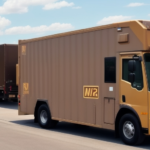Comparing USPS and UPS Shipping Rates: Which Offers the Best Postage?
Choosing the most cost-effective and reliable shipping service is crucial for both individuals and businesses. In the United States, two of the most prominent shipping providers are the United States Postal Service (USPS) and United Parcel Service (UPS). This article provides an in-depth comparison of their shipping rates, delivery times, tracking features, insurance coverage, customer service, and more, helping you determine which service offers the best postage for your specific needs.
Overview of USPS and UPS Shipping Services
The USPS is a government-operated postal service offering a range of shipping options, including Standard Post, Media Mail, First-Class Mail, Priority Mail, Express Mail, and International Mail. Conversely, UPS is a privately-owned company that provides package delivery, ground shipping, air freight, and comprehensive logistics services for both businesses and individuals.
One of USPS's key advantages is its affordability, particularly for small and lightweight packages. With an extensive network of post offices and drop-off locations nationwide, USPS ensures convenient access for customers. Additionally, USPS offers tracking information for most of its shipping services, enabling customers to monitor their packages in real-time.
UPS is renowned for its reliable and expedited delivery services, especially for time-sensitive shipments. It provides a variety of additional services such as insurance, signature confirmation, and delivery confirmation, enhancing security and peace of mind. Moreover, UPS boasts a strong international presence, shipping to over 220 countries and territories globally.
For more detailed information on UPS shipping options, visit UPS shipping rates.
USPS Shipping Rates: How They Work
USPS shipping rates are determined by the package's weight, dimensions, and destination. Among the various options, Priority Mail is the most popular due to its balance of speed and affordability, typically delivering within 1-3 business days domestically. USPS also offers flat-rate boxes for Priority Mail, allowing for cost-effective shipping of heavy items regardless of size.
Additional services such as insurance, tracking, and signature confirmation can influence the overall shipping cost. These services offer enhanced security for both sender and recipient but come at an extra fee. When selecting USPS services, it's advisable to assess the package's value and the necessary level of protection to choose the appropriate additional options.
For more insights on UPS shipping rates, refer to the UPS shipping rate guide.
Factors Affecting USPS and UPS Shipping Rates
Several factors influence shipping rates for both USPS and UPS:
- Weight and Size: Heavier and larger packages typically cost more to ship.
- Distance: Longer distances increase shipping costs.
- Delivery Timeframes: Faster delivery options come at a premium.
- Additional Services: Insurance, tracking, and signature confirmation add to the cost.
- Package Type: Hazardous or fragile items may incur extra handling fees.
Understanding these factors is essential for selecting the most cost-effective shipping option. Additionally, international shipping rates can be affected by customs regulations and tariffs, which vary by country.
Pricing Comparison between USPS and UPS Shipping Services
When comparing pricing, USPS generally offers more affordable rates for smaller and lighter packages. For instance, USPS First-Class Mail starts at $0.58 for letters, making it ideal for personal correspondence and small parcels. In contrast, UPS may provide better rates for larger and heavier shipments, especially when volume-discount options are applied.
USPS's flat-rate boxes are advantageous for shipping items like books, clothing, and small electronics, offering predictable pricing regardless of the package weight. UPS, on the other hand, provides a broader spectrum of shipping options, including ground, air, and international services, catering to diverse business needs.
According to the 2024 shipping rate analysis, USPS remains more cost-effective for e-commerce businesses shipping lightweight products, while UPS is preferred for high-volume shipments requiring expedited delivery.
Delivery Time Comparison between USPS and UPS Shipping Services
Delivery times vary between USPS and UPS based on the selected shipping option:
- USPS Priority Mail: Typically delivers within 1-3 business days across the U.S.
- UPS Ground: Average delivery time is 1-5 business days, depending on the distance.
- UPS Express: Offers next-day delivery to certain areas.
Both services provide expedited and express shipping options for urgent deliveries. However, external factors like weather conditions, holidays, and peak shipping seasons can affect delivery times. During high-demand periods, such as the holiday season, expect potential delays due to increased package volumes.
It's advisable to plan shipments accordingly and allow additional time during these busy periods to ensure timely delivery.
Tracking Features Comparison between USPS and UPS Shipping Services
Both USPS and UPS offer robust tracking systems:
- USPS: Provides tracking for most services, including international shipments. Features like Informed Delivery allow customers to preview incoming mail and packages.
- UPS: Offers more advanced tracking capabilities, including real-time updates, email and text alerts, and customizable delivery instructions.
For packages requiring detailed tracking and timely updates, UPS's enhanced tracking features may be preferable. USPS's tracking is reliable for standard shipments, especially within the domestic network.
Insurance Coverage Comparison between USPS and UPS Shipping Services
Insurance options differ between USPS and UPS:
- USPS: Offers up to $5,000 in insurance coverage for Priority Mail. Insurance costs vary based on the package's declared value.
- UPS: Provides up to $100,000 in insurance coverage for certain packages. UPS charges a flat rate for coverage up to a specific amount, with additional fees for higher coverage levels.
When shipping high-value items, UPS may be the better choice due to its higher coverage limits. However, it's essential to review each provider's insurance policies and coverage restrictions to ensure adequate protection for your shipments.
Customer Service Comparison between USPS and UPS Shipping Services
Customer support quality can significantly impact the shipping experience:
- USPS: Offers standard customer service through phone and online resources. While helpful, service options may be limited compared to UPS.
- UPS: Provides more personalized customer service, including dedicated lines for small businesses and extensive online support tools such as live chat.
For businesses requiring specialized support and quick issue resolution, UPS's customer service infrastructure may offer greater benefits.
Pros and Cons of Using USPS for Shipping
Pros:
- Affordability, especially for lightweight and small packages.
- Extensive network of post offices and drop-off locations.
- Various shipping options, including flat-rate boxes.
- Commitment to sustainability with eco-friendly initiatives.
Cons:
- Longer delivery times compared to UPS.
- Less advanced tracking features.
- Limited insurance coverage for high-value packages.
- Risk of lost or damaged packages despite tracking and insurance options.
Pros and Cons of Using UPS for Shipping
Pros:
- Fast and reliable delivery options, including next-day service.
- Wide range of shipping options tailored to various needs.
- Advanced tracking features with real-time updates.
- Extensive international shipping capabilities.
Cons:
- Higher shipping rates for certain packages.
- Limited availability in some rural or remote areas.
- Additional fees for specialized services and handling.
Which is the Cheapest: USPS or UPS?
Generally, USPS is more economical for smaller and lighter packages, making it ideal for individual shipments and small businesses selling lightweight products. In contrast, UPS tends to be more cost-effective for larger, heavier shipments, especially when utilizing volume discounts available to businesses.
The 2024 rate comparison indicates that USPS maintains a pricing edge for parcels under 5 pounds, while UPS offers competitive rates for bulk and heavy shipments above this threshold.
Which is the Fastest: USPS or UPS?
UPS generally provides faster delivery options compared to USPS, particularly with its Express services that offer next-day delivery to select destinations. For urgent shipments requiring swift delivery, UPS's expedited services are often the preferred choice.
USPS, while not as fast as UPS's premium services, offers competitive delivery times for standard services like Priority Mail, which delivers within 1-3 business days domestically.
For time-sensitive deliveries, evaluating the specific service levels and corresponding delivery guarantees of each provider is essential.
Which Offers Better Tracking Features: USPS or UPS?
UPS stands out with its more advanced tracking features, providing real-time updates, customizable delivery instructions, and proactive tracking alerts via email or text message. These features offer enhanced visibility and control over shipments.
USPS offers reliable tracking for most services, including international shipments, and features like Informed Delivery for mail and package previews. While effective, USPS's tracking capabilities are not as comprehensive as UPS's offerings.
Which Offers Better Insurance Coverage: USPS or UPS?
UPS provides more extensive insurance coverage options, offering up to $100,000 for certain high-value packages. This makes UPS a suitable choice for shipping expensive items that require substantial protection.
USPS offers insurance coverage up to $5,000 for Priority Mail shipments, which is sufficient for moderately valued items. However, for high-value goods, UPS's insurance options may be more appropriate.
Tips for Choosing Between USPS and UPS for Your Shipping Needs
When deciding between USPS and UPS, consider the following factors:
- Package Weight and Size: USPS is more economical for lighter packages, while UPS may offer better rates for larger, heavier shipments.
- Destination: For international shipping, both providers have extensive networks, but UPS may offer more comprehensive tracking and faster delivery options.
- Urgency: Choose UPS for expedited delivery needs; USPS is suitable for standard delivery timelines.
- Tracking and Insurance: If advanced tracking and higher insurance coverage are essential, UPS is the preferable option.
- Budget: Assess your budget constraints and shipping frequency to determine which provider offers the best value for your specific requirements.
By carefully evaluating these factors, you can select the shipping service that aligns best with your logistical needs and budget.
In summary, both USPS and UPS offer a variety of shipping options catering to different needs. By comparing their rates, delivery times, tracking features, insurance coverage, and customer service, you can make an informed decision on which service provides the best postage for your specific shipping requirements.






















